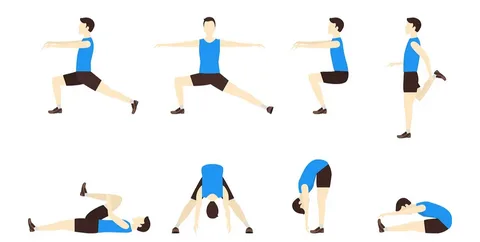Strength training is one of the most effective ways to improve your overall health, build muscle, and boost your fitness levels. However, for many beginners, the idea of starting a strength training routine can feel overwhelming. With so much information available, it’s easy to get lost in the details. The good news is that strength training doesn’t have to be complicated. In this article, we’ll break it down into simple, actionable steps to help you get started on your journey to a stronger, healthier you.
What is Strength Training?
Strength training, also known as resistance training, involves exercises that improve muscular strength and endurance by working against a force. This force can come from weights, resistance bands, or even your own body weight. The goal is to challenge your muscles, causing them to adapt and grow stronger over time.
Benefits of Strength Training
- Builds Muscle Mass: Regular strength training helps increase muscle size and strength, which can improve your physical appearance and performance.
- Boosts Metabolism: Muscle burns more calories at rest than fat, so building muscle can help you maintain a healthy weight.
- Improves Bone Health: Resistance training strengthens bones, reducing the risk of osteoporosis and fractures.
- Enhances Mental Health: Exercise releases endorphins, which can reduce stress, anxiety, and depression.
- Increases Functional Strength: Everyday tasks like lifting groceries or climbing stairs become easier as you get stronger.
Getting Started with Strength Training
Here’s how to simplify your strength training journey:
1. Set Clear Goals
- Determine what you want to achieve. Are you looking to build muscle, lose fat, or improve overall fitness? Your goals will guide your training plan.
2. Start with Bodyweight Exercises
- If you’re new to strength training, begin with bodyweight exercises like push-ups, squats, lunges, and planks. These movements help you build a foundation of strength and proper form.
3. Incorporate Basic Equipment
- As you progress, add resistance using dumbbells, kettlebells, or resistance bands. Start with light weights and focus on mastering the movements.
4. Focus on Compound Movements
- Compound exercises work multiple muscle groups at once, making them efficient and effective. Examples include:
- Squats (legs, glutes, core)
- Deadlifts (back, glutes, hamstrings)
- Bench press (chest, shoulders, triceps)
- Rows (back, biceps)
5. Keep It Simple
- You don’t need a complicated routine. A basic full-body workout performed 2-3 times per week is enough to see progress. For example:
- Squats: 3 sets of 10-12 reps
- Push-ups: 3 sets of 8-10 reps
- Bent-over rows: 3 sets of 10-12 reps
- Plank: 3 sets of 20-30 seconds
6. Prioritize Proper Form
- Good form is crucial to prevent injuries and maximize results. If you’re unsure, consider working with a trainer or watching instructional videos.
7. Progress Gradually
- As you get stronger, gradually increase the weight, reps, or sets. This principle, known as progressive overload, is key to continuous improvement.
Tips for Success
- Warm Up and Cool Down: Always start with a 5-10 minute warm-up (e.g., jogging or dynamic stretches) and end with a cool-down to prevent injury.
- Rest and Recover: Muscles need time to repair and grow. Aim for at least one rest day between strength training sessions.
- Stay Consistent: Results take time, so stick with your routine and be patient.
- Fuel Your Body: Eat a balanced diet rich in protein, healthy fats, and carbohydrates to support muscle growth and recovery.
Common Mistakes to Avoid
- Skipping Warm-Ups: Jumping straight into heavy lifting increases the risk of injury.
- Lifting Too Heavy Too Soon: Start with manageable weights and focus on form.
- Neglecting Recovery: Overtraining can lead to burnout and injuries.
- Ignoring Nutrition: Your diet plays a critical role in your strength training results.
Sample Beginner Strength Training Routine
Here’s a simple full-body workout to get you started:
- Bodyweight Squats: 3 sets of 10-12 reps
- Push-ups: 3 sets of 8-10 reps
- Bent-over Rows (with dumbbells): 3 sets of 10-12 reps
- Plank: 3 sets of 20-30 seconds
- Glute Bridges: 3 sets of 12-15 reps
Perform this routine 2-3 times per week, with at least one rest day in between.
Final Thoughts
Strength training doesn’t have to be complicated or intimidating. By starting small, focusing on proper form, and staying consistent, you can build strength, improve your fitness, and achieve your goals. Remember, progress takes time, so be patient and celebrate small victories along the way. Whether you’re lifting weights at the gym or doing bodyweight exercises at home, the key is to keep it simple and enjoy the process.
Start today, and you’ll be amazed at what your body can achieve!
FAQs
1. How quickly will I see results from strength training?
Expect noticeable changes in 4–8 weeks with consistent effort.
2. Do I need a gym membership to get started?
No! Many effective exercises use bodyweight or simple equipment like resistance bands.
3. Can I combine strength training with cardio?
Yes! A balanced fitness plan includes both for maximum health benefits.
4. What if I have injuries or health conditions?
Consult a healthcare professional or certified trainer for a tailored program.






